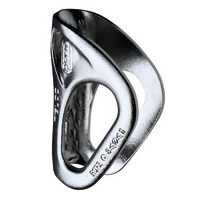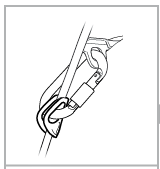Simul-Climbing: Managing Danger from Falls
by Michael Powers, IFMGA
AAI Senior Guide & Director for Staff Development
Question:
From the March 2006 edition of AAI's E-newsletter

A Petzl Tibloc emergency ascender.
I have read that using an occasional Tibloc or Gibbs ascender on anchors while simul-climbing will keep the load from a falling second from pulling off the leader. This solution may be more of a problem than the one it was attempting to solve as these devices are not recommended to hold a fall. Please share any experience or ideas on how a prussik or other friction knot may be used in this scenario.
- Greg Rossell (Durango, CO)
Answer:
Dear Greg,

Petzl's recommended use of the Tibloc for simul-climbing protection.
Yes, a Tibloc (or similar) will prevent the second climber from pulling the leader off. The disadvantage is the stress they put on the rope (they can shear the sheath off the rope or worse). However, this is preferable to pulling the leader off their lead. So, in this sense it can be acceptable if the alternative to a damaged rope is a protected leader.
Realistically, when this type of protection is used, falls rarely happen and the use of the tibloc is more of a "psychological pro" that, perhaps in certain limited situations, is sufficient. More common is using running protection with no load limiters and allowing backwards movement, which would still keep the climbing team attached to the mountain in case of a fall (but, bear in mind, the leader may get pulled off their stance). The other disadvantage of the tiblocs is the extra friction created when the leader is climbing - it's ok for one or two devices to be attached but with more than that, the drag becomes too great.
Prusiks are considered too unreliable to tighten on their own and take too long to attach to the rope - by the time the leader places three, four, or say, six prusiks to each ice screw, or other piece of protection, and attaches them to the lead rope, the climbers might as well climb one at a time and do normal belay techniques. The whole idea of simul-climbing is to save time, so using many of these devices, especially prusik hitches, ends up not saving any time at all. Realistically, if the terrain can be simul-climbed, then generally the climbers accept the chance of a fall. Otherwise they will climb using normal belay tactics.
- Mike Powers
Click the link to return to "Ask A Guide" Letters.
Program Finder